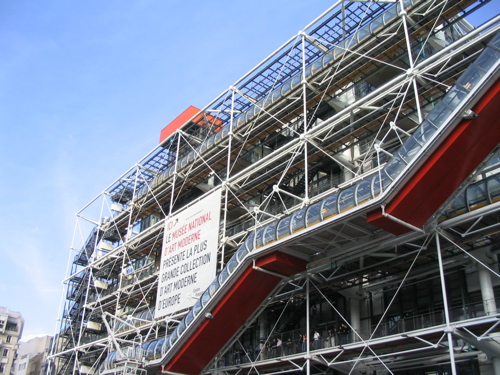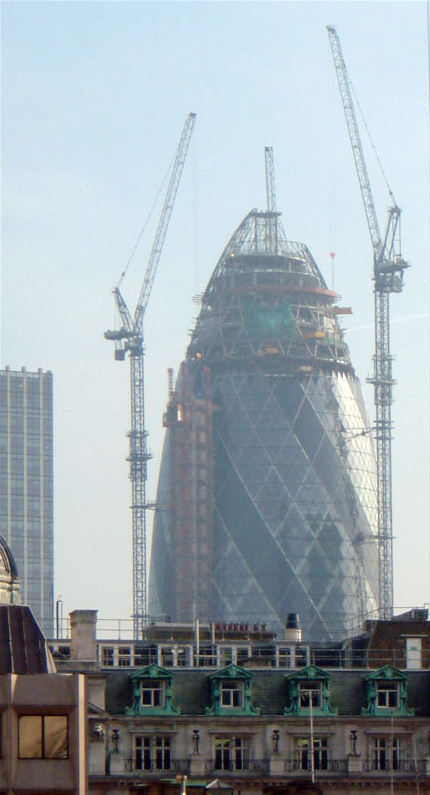
1977. Pompidou Centre. Exposed trusses, ducts, electrical conduit, metal decking.
From *clarity*'s photostream, flickr.
Last of the form / function posts, for now anyway.
Functionally-shaped buildings are remarkably hard to find, other than limited groups which have clear and apparent forces at work to determine their forms:
Tents make up one group, with their push-pull structures and pliant envelopes. Some creative examples.
Yurts are another, or maybe a subgroup of tents.
Some industrial uses make up another group, with facilities like oil refineries, rail service structures and grain elevators.
Mobile dwellings, notably Airstream, are another. Houseboats, ocean liners and today's cruise ships are less confined in their formal characteristics than some of the structures in this list, but are quite recognizable for what they are and the purposes they serve.
The presence of functional imargery in building types without the overwhelming incentives present in the examples of the preceding list are much less common. This isn't surprising, but it can sometimes be a missed opportunity to mine the aesthetic potential latent within many buildings' program requirements. Renzo Piano and Richard Rogers designed the iconic and widely-appreciated Pompideau Centre in Paris. This museum is generally described as "high tech," but along with its high-tech imagery, it represents a studied effort to thrust many of the building's functional elements and processes into view.

Pompidou Center. wiki

From lewishamdreamer's photostream, flickr
Detail photo of Pompidou Center. Exposed structure, electrical conduit, service access platforms, welded wire mesh railing. This thirty-two-year-old building bluntly delineates functional elements as a deliberate, carefully composed aesthetic.
Rogers' one-time business partner, Norman Foster, carried his own inquiries into technical expression of functional imagery into the production of highly accomplished work. His firm's 30 St. Mary Axe office building in London is an exemplary collaboration between the architect, structural engineer Ove Arup and mechanical engineer Hilson Moran. The interwoven design is explained in this wiki article. It's unmistakable on the skyline, and has prompted hilarious nicknames, but is highly sophisticated structurally and mechanically. With due acknowledgment of "Towering Innuendo" and "Chrystal Phallas" nicnames, the more primary formal expression of this building is, I think, its triangulation of structure and aerodynamics, which evade wind loads while driving its natural ventilation system.

30 St. Mary Axe. London.
Through the broad sweep of architectural history, form has ebbed back and forth from unadorned functional construction to highly stylized periods like 16th-century mannerists of Italy or 18th-century Roccoco. The thrust has almost always been toward more sylized imagery. In the examples of mannerism and later roccoco, a stylisitc evolution matured, where increasingly numerous, layered factors influenced architectural expression with only the minimum necessary evidence of functional elements. In fact, function is often hidden, disguised or sacrificed to satisfy formal considerations. (Ironically enough, this occurred commonly enough in the 20th century and even now, trying to give a building a functional and machine-like image when its actual construction was of earlier, more primitive means and materials.)
Among factors likely to introduce opportunities for less arbitrary building imagery are those related to sustainability and the conservation of energy. Provison of fixed or movable shading devices, permeable, "breathing" envelope systems and wind turbines of various configurations can have substantial visible effect on a building's form. Partially underground construction is another potential form-giver. Integration of building envelope with plant material in both traditional and yet-to-be-developed ways offer intriguing departures from past and current design precepts.
Without trying to turn this into a manifesto, I think it quite possible that necessities of sustainability and conservation of resources, already increasingly evident, will over time usher in a technically sophisticated, broad design motif of literal and honest expression of function. Along with this, a new and widely understood aesthetic can evolve. Would or should this become a dominant aesthetic? I hope no realtively narrow aesthetic vision ever becomes "dominant," but I think new forms based on new capacities to intrepret and produce them is positive and an altogether exciting prospect.
Of general interest, an outstanding archive of Thomas Mayer photos.

No comments:
Post a Comment